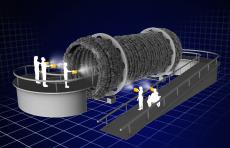Part of a series of interviews with current and past Rubys grantees. Interested in applying to receive a Rubys grant? Go here.
- Grantee: Eric Dyer
- Grant Year: 2014
- Grant Discipline: Media Arts
 Eric Dyer is an artist, filmmaker, experimental animator, and educator, whose artwork and films have been exhibited internationally. Eric received a Rubys grant in 2014 to support the development of The Zoetrope Tunnel, a large-scale moving sculpture based on the zoetrope, a pre-cinema optical toy. Eric is also a 2015 Baker Artist Award winner. Eric will be discussing his work on The Zoetrope Tunnel on June 25 at 5pm as part of MICA’s MFAST public lecture series. More information on the lecture can be found here.
Eric Dyer is an artist, filmmaker, experimental animator, and educator, whose artwork and films have been exhibited internationally. Eric received a Rubys grant in 2014 to support the development of The Zoetrope Tunnel, a large-scale moving sculpture based on the zoetrope, a pre-cinema optical toy. Eric is also a 2015 Baker Artist Award winner. Eric will be discussing his work on The Zoetrope Tunnel on June 25 at 5pm as part of MICA’s MFAST public lecture series. More information on the lecture can be found here.
GBCA: You were born in Baltimore. Has being a Baltimore native shaped your art practice in any way?
Eric: I've lived in Germany, Los Angeles, San Jose, New York, Denmark… but I always return to my hometown. Summer's honeysuckle scents and embracing humidity, the style of the street lamps, our everyday slang— simple details make Baltimore feel like home and, along with family and longtime friends, provide a subconscious security conducive to making my work. Plus, this city is diverse, full of smart and interesting people, close to New York, and has a rare feeling of authenticity. That said, intentionally upending comfort and familiarity by occasionally moving away for several months has been essential to finding inspiration.
GBCA: How did you become interested in the zoetrope, a 19th century animation device? How is it meaningful today?
Eric: Working as a freelance animator and experimental filmmaker had me starring at screens endlessly. The zoetrope provided a means to get my hands on the animation, present it as sculpture in physical environments, and explore the creative and expressive possibilities of an under-recognized “format.” With most of society working and socializing though increasingly virtual means, it seems there’s a new appreciation for “real” objects and experiences.
GBCA: How do you see video and animation evolving in the future?
Eric: Today it’s difficult to imagine that the first cinema audiences jumped from their seats when watching the Lumière Brothers’ Arrival of a Train at La Ciotat (1896). We’ve perhaps reached the opposite end of the movie-wonder spectrum. Considering YouTube’s boasting of 4 billion views per day and Hollywood’s scramble to recapture audiences’ attentions with tricks like stereoscopy (3D movies), it seems like the screen-based moving image has become almost dismissively commonplace, void of its former power to impact viewers viscerally. Pulling work off the screen and adding interactivity will be important steps in reclaiming the power of moving images.
GBCA: What is next for your work on the Zoetrope Tunnel?
Eric: I’ve spent the last year (with the help of the Ruby grant) testing ideas and processes on a small-scale rotating tunnel (8” long x 4” diameter). Enough has been learned to move forward with the fabrication of the full-scale walk-through tunnel, and UMBC has provided me with an on-campus space to work on it.

Draft model of Zoetrope Tunnel, 2014

 Eric Dyer is an artist, filmmaker, experimental animator, and educator, whose artwork and films have been exhibited internationally. Eric received a Rubys grant in 2014 to support the development of The Zoetrope Tunnel, a large-scale moving sculpture based on the zoetrope, a pre-cinema optical toy. Eric is also a 2015 Baker Artist Award winner. Eric will be discussing his work on The Zoetrope Tunnel on June 25 at 5pm as part of MICA’s MFAST public lecture series.
Eric Dyer is an artist, filmmaker, experimental animator, and educator, whose artwork and films have been exhibited internationally. Eric received a Rubys grant in 2014 to support the development of The Zoetrope Tunnel, a large-scale moving sculpture based on the zoetrope, a pre-cinema optical toy. Eric is also a 2015 Baker Artist Award winner. Eric will be discussing his work on The Zoetrope Tunnel on June 25 at 5pm as part of MICA’s MFAST public lecture series. 
